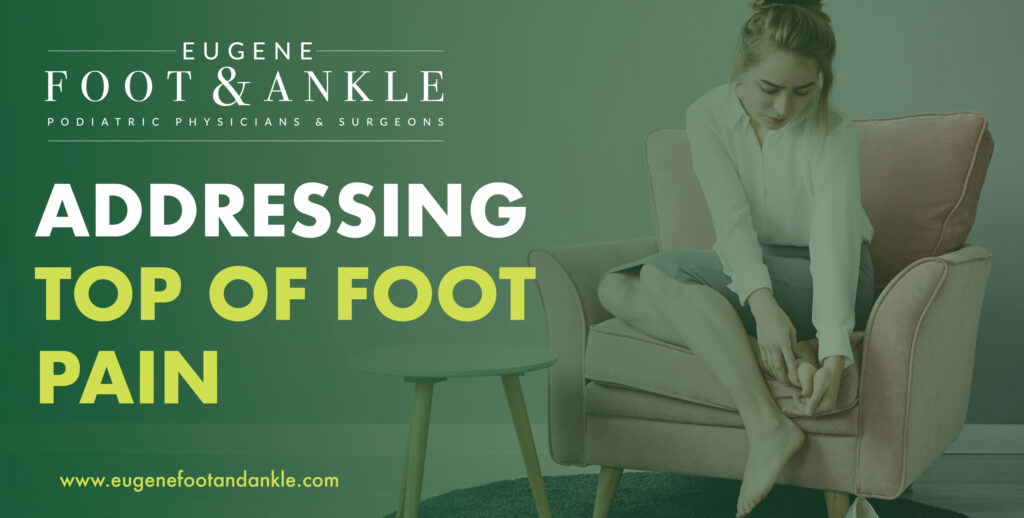Addressing Top of Foot Pain
Pain that emerges on the top of the foot most often results from an injury or an underlying medical condition. Fortunately, top of foot pain rarely requires surgery. Here’s what to know about what causes pain on the top of the foot and how podiatrists help you to get relief.

What is Causing My Top of Foot Pain?
Pain on the top of your foot is often due to an injury. However, it’s important to note that you need not suffer an acute injury. Overuse injuries also result in top of foot pain. The most common injuries that lead to pain on the top of your foot include:
- Inflammation of the Sinus Tarsi
The tube (tunnel) that runs between the talus (lower ankle) and calcaneus (heel) bones is called the sinus tarsi. Injuries such as ankle sprains or those caused by repetitive activities can cause the sinus tarsi to become inflamed. People who have flat feet may also experience inflammation of the sinus tarsi (known as sinus tarsi syndrome) from walking. Sinus tarsi syndrome often results in pain on the top of the foot.
- Midfoot Injuries
The culprit behind most midfoot injuries is a dropped object. Dropping a heavy object or an object with sharp edges can result in a deep bone bruise or even a fracture. Midfoot injuries can cause pain in addition to bruising and swelling.
- Stress Fractures
Stress fractures are tiny cracks that can develop in the bones of your feet. They often result from walking, running, or jumping repeatedly. Repetitive motion is to blame for most stress fractures, and these tiny cracks are quite common among athletes. However, those who suffer from weakened bones may develop stress fractures from everyday activities, including walking.
- Tendinitis
Inflammation or a tear in the extensor tendons, which are located on the top of the foot, can cause pain. Known as extensor tendinitis, this painful condition often responds well to conservative treatments.
Medical conditions that can cause pain on the top of the foot include:
- Arthritis
There are more than 100 different types of arthritis, all of which may cause pain on the top, back, and sides of the feet. The most common types of arthritis that cause pain in the feet are osteoarthritis, rheumatoid arthritis, and gout.
- Gout
Gout is a specific type of arthritis caused by a buildup of uric acid in your body. The uric acid forms crystals at joints in the feet, which can cause significant pain.
- Ganglion Cyst
Ganglion cysts commonly develop on the top of the foot. They are non-cancerous sacs filled with a jellylike substance. Although we don’t understand why certain people develop these harmless but potentially painful cysts they likely develop from either acute trauma or repetitive microtrauma to the top of the foot.
- Nerve Pain (Diabetic Neuropathy and Peroneal Nerve Dysfunction)
Diabetic neuropathy and peroneal nerve dysfunction can both cause top of foot pain. Nerve damage due to diabetes typically includes symptoms such as tingling, numbness, and pain in the feet. The peroneal nerve is a branch of the sciatic nerve that is responsible for sensation on the top of the foot. If this nerve becomes injured or damaged, you may experience the same symptoms of neuropathy in the feet.

Diagnosing Pain Across the Top of the Foot
Persistent pain across the top of your foot should be treated by an experienced podiatrist. To diagnose the cause of your foot pain, your podiatrist will perform the following:
Examination
An examination to look for bruising or swelling will be performed. Your podiatrist will also move your foot, ask you to flex it up and down, and evaluate your foot while you walk.
Medical History
Your podiatrist will also ask for a complete medical history and a history of any injuries you’ve sustained.
Blood Tests
If your podiatrist suspects gout or diabetes, you may also require blood tests.
Imaging Tests
Imaging tests such as x-rays, ultrasound, or MRIs may be necessary to locate stress fractures, identify inflammation of the soft tissues, and diagnose arthritis in the feet.
Treatments for Pain on the Top of Your Foot
Surgery is rarely required to alleviate pain along the top of the foot. Conservative treatments such as anti-inflammatory medications, rest, physical therapy, custom orthotics, or a boot or brace are often all that is necessary to allow your foot to heal.
Ganglion cysts may need to be drained (aspirated). Arthritis may require steroid injections to reduce inflammation. In rare cases, a ganglion cyst may require surgical removal.
Non-Surgical Treatment for Foot Pain in Eugene
If you’re experiencing foot pain that will not subside, schedule an appointment at Eugene Foot and Ankle by calling 541-683-3351. Our team includes Board-Certified podiatrists who will accurately diagnose the cause and prescribe a treatment plan to help you get relief from top of foot pain.
Contact Us
Eugene
Hours:
Monday............ 8:00am - 5:00pm
Tuesday............ 8:00am - 5:00pm
Wednesday............ 8:00am - 5:00pm
Thursday............ 8:00am - 5:00pm
Friday............ 8:00am - 4:00pm (Only available on phones)
Closed for lunch from 12pm - 1pm and closed until 1:30pm on Tuesdays
© Copyright 2025 Eugene Foot and Ankle. All Rights Reserved. | Privacy Policy.
